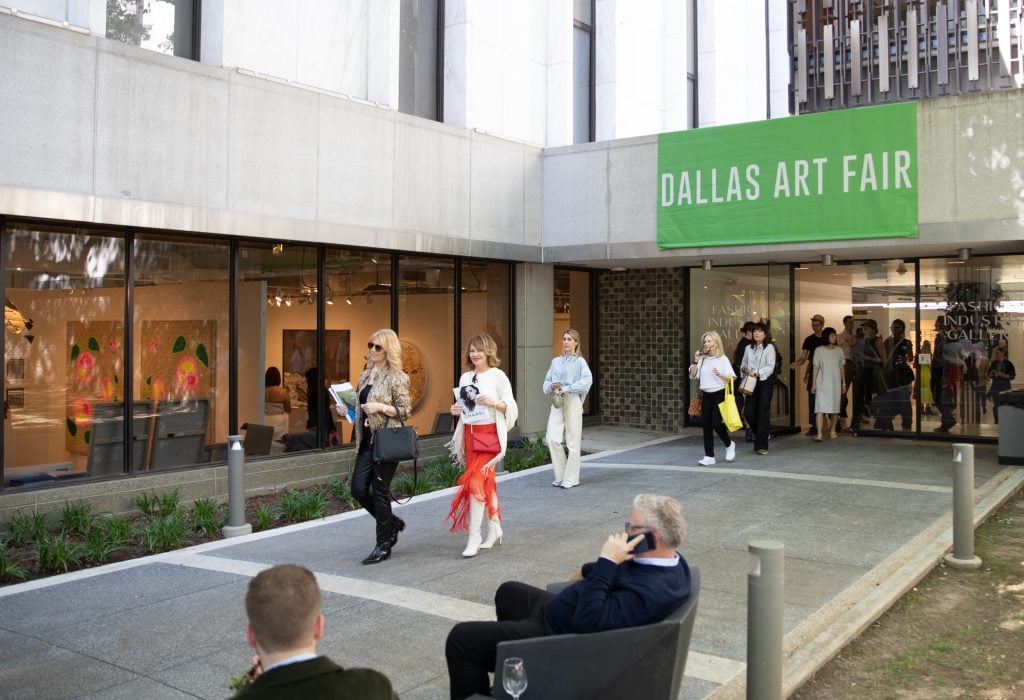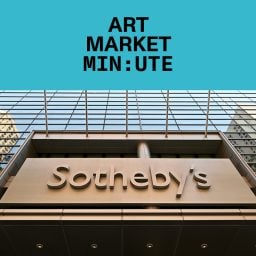The VIP opening of the Dallas Art Fair last week was ebullient, gregarious, and packed. On Thursday, as the complimentary champagne and iced tea flowed at the Fashion Industry Gallery, the crowd was largely made up of locals, including Dallas Mavericks coach Jason Kidd, former player Dirk Nowitzki, and power-collectors Howard Rachofsky and Adam Green. Christopher Scott, of the local gallery Tureen, described the mood as “lighthearted,” and Los Angeles-based Ben Lee Ritchie Handler, of Nicodim, characterized the city’s art scene as “welcoming.”
Although Dallas is renowned for its blue-chip private collections, the fair aims to court a notably wider audience. Its 91 exhibitors—smaller and mid-tier contemporary dealers from Dallas, New York, L.A., and beyond, plus a few larger international ones, like Max Hetzler and Perrotin—had a little something for everyone: emerging painting, secondary market works, and even fine estate jewelry.
If there was one recurring trend, it was purplish landscapes with neon-orange underpainting, borrowing qualities of both Salvo’s in-demand canvases and David Hockney’s iPad drawings. (My personal highlight was a polymer collage by Sonya Kelliher-Combs at Tureen.) I told the fair’s director, Kelly Cornell, that the selection felt accessible, and she said that it was closely tailored to its audience: “We’ve been inside their homes, and so we know how they collect.”
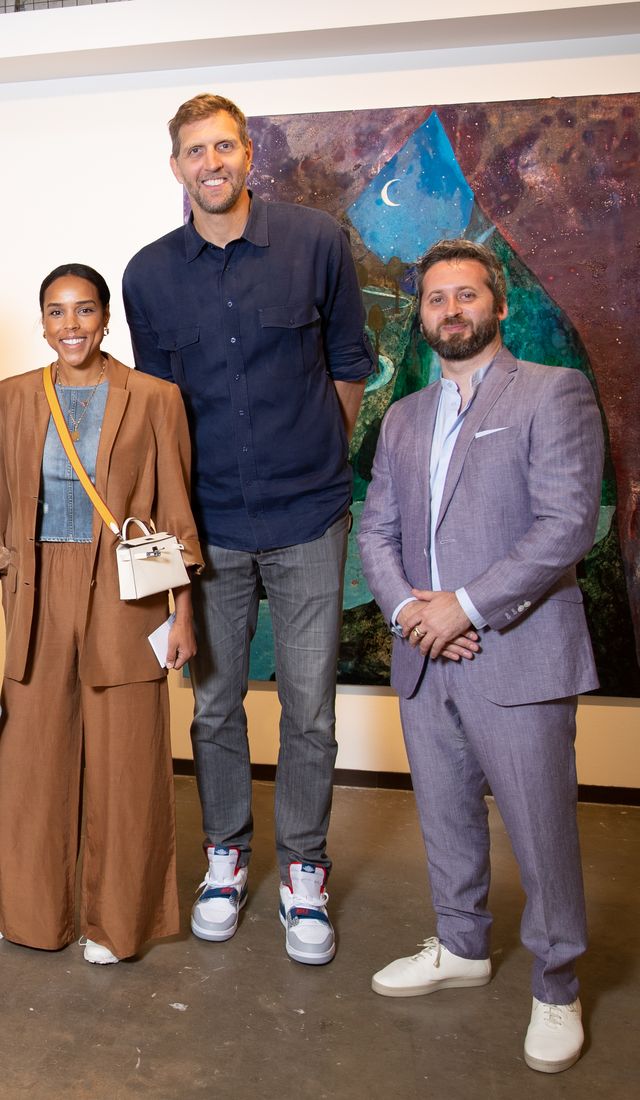
Businesswoman and philanthropist Jessica Nowitzki, her husband, Dallas Mavericks great Dirk Nowitzki, and dealer Josh Lilley at the Dallas Art Fair. Photo courtesy DAF
The fair, which closed Sunday, is marked by certain customs. Prices, often labeled, ranged from the low thousands to the hundred-thousands, though Dallas dealer Anna Meliksitian said that $15,000 to $20,000 has proven to be an ideal range. Collectors rarely place formal holds, several dealers told me, but typically return to the fair multiple times before making a decision, often on the final day. One L.A. advisor told me that Dallas collectors take this time to consider if and where a work might fit in their homes, joking that they bring their tape measures to the fair. (I did spot at least one painting whose listed dimensions had been crossed out and corrected.)
The pace is frequently characterized as “easygoing,” but it would be more accurate to say the opposite—that collectors here take their purchases very seriously. With none of the manufactured urgency that marks the bigger global fairs, they buy what they like, spending time to deliberate on whether or not they truly like it.
New acquisitions are considered meaningful additions to a home. “A lot of people here collect as a family,” said Will Hathaway, of L.A.’s Night Gallery, a longtime DAF exhibitor that was showing across the street at the Dallas Invitational fair this year. “Part of the family might come in on Thursday, and then everyone comes together on Saturday.” Many also consider their collections a representation of their values. “If you buy art that you truly enjoy, it reflects the way you look at life,” local mega-collector Kenny Goss told me, stressing the hang as an art form in itself. “It’s important to present the artwork you buy in an incredible way, so that other people love it, too.”
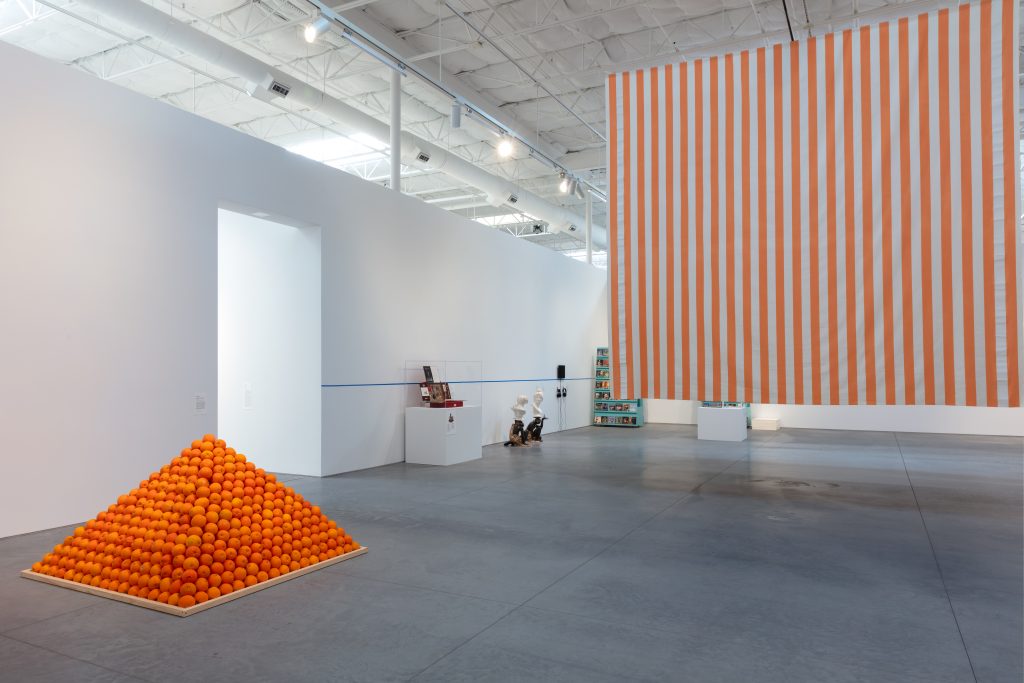
Installation view of “For What It’s Worth: Value Systems in Art Since 1960″ at the Warehouse, with works by Roelof Louw and Daniel Buren at front. Photo courtesy the Warehouse
ART AT HOME
In Dallas, leading contemporary galleries, including 12.26, Erin Cluley, Keijsers Koning, and PDNB, are concentrated in River Bend, a neighborhood developed by Dallas Art Fair owner John Sugrue. The central hub of the city’s design trade, it’s where you can meet your interior designer and peruse fabric swatches on the way to buying a new painting. On Friday night I went there for an opening at Meliksetian Briggs—a group show curated by L.A. advisor Luana Hildebrandt that includes Bas Jan Ader and emerging painters Yifan Jiang and Ben Noam—and ran into Goss and his friend and fellow collector Jane Weempe, a general contractor who shared her thoughts about art’s connection to the home.
“A lot of interior designers in Dallas want you to walk into a house and say, ‘Oh, this is a so-and-so.’ But no no no, to me, if you’re a good interior designer, you draw out what a person wants,” she told me. “The [client] might not have style or taste, but bring it out! People should walk in and say, ‘That looks like you.’” (When I asked her if designers play an art-advisory role, Goss politely interjected: “Never let your interior designer give an opinion on your art.”)
Major private collections in Dallas may not rely on interior designers, but they do have their distinct sensibilities. The current hang at the modernist guesthouse in Marguerite Hoffman’s four-acre backyard—including Cecily Brown, Robert Gober, Anicka Yi, Joseph Cornell, and many more—is a portrait of historical and critical importance, prestige, pristine elegance, and restraint.
By contrast, the Green Family Art Foundation’s off-site painting exhibition in the lobby of a luxury apartment complex, “In the Know, Show,” features relative unknowns—“strategically acquired works by rising artists who we feel have promising futures,” its director, Bailey Summers, explained. The foundation’s own space currently has works on loan from Pamela and David Hornik, Bay Area collectors with a similar affinity for rising artists. In that show, “Some Dogs Go to Dallas,” an interesting mix of recent market sensations (Amoako Boafo, Louis Fratino) are united by their imagery of people holding dogs.
The best show in town is “For What It’s Worth: Value Systems in Art Since 1960,” on view at the Rachofskys’ Warehouse and co-organized by its curator, Thomas Feulmer, and Lisa Le Feuvre, the director of the Holt/Smithson Foundation. The rigorously curated, immaculately installed exhibition draws out the poetry of conceptual art, with works by Roelof Louw, Walid Raad, Lorraine O’Grady and many others that you’re not likely to find at an art fair.
Goss—a true Texan with an accent and hat collection to match—is perhaps best known for his in-depth collection of Young British Artists, having lived in London for many years with his late partner, pop icon George Michael. We met after the first day of the fair, and as a gay man’s gesture of Southern hospitality, he took me to a strip club called Pandora’s to discuss art over Diet Cokes. He said his early purchase of a Bridget Riley painting three decades ago was made at an art fair, under duress: Dealer “Tim Taylor told me I had 15 minutes to make up my mind, and I was naive enough to think that was true.” Still, Goss expressed no regrets: “Hanging over my fireplace, that thing looked damn incredible.”
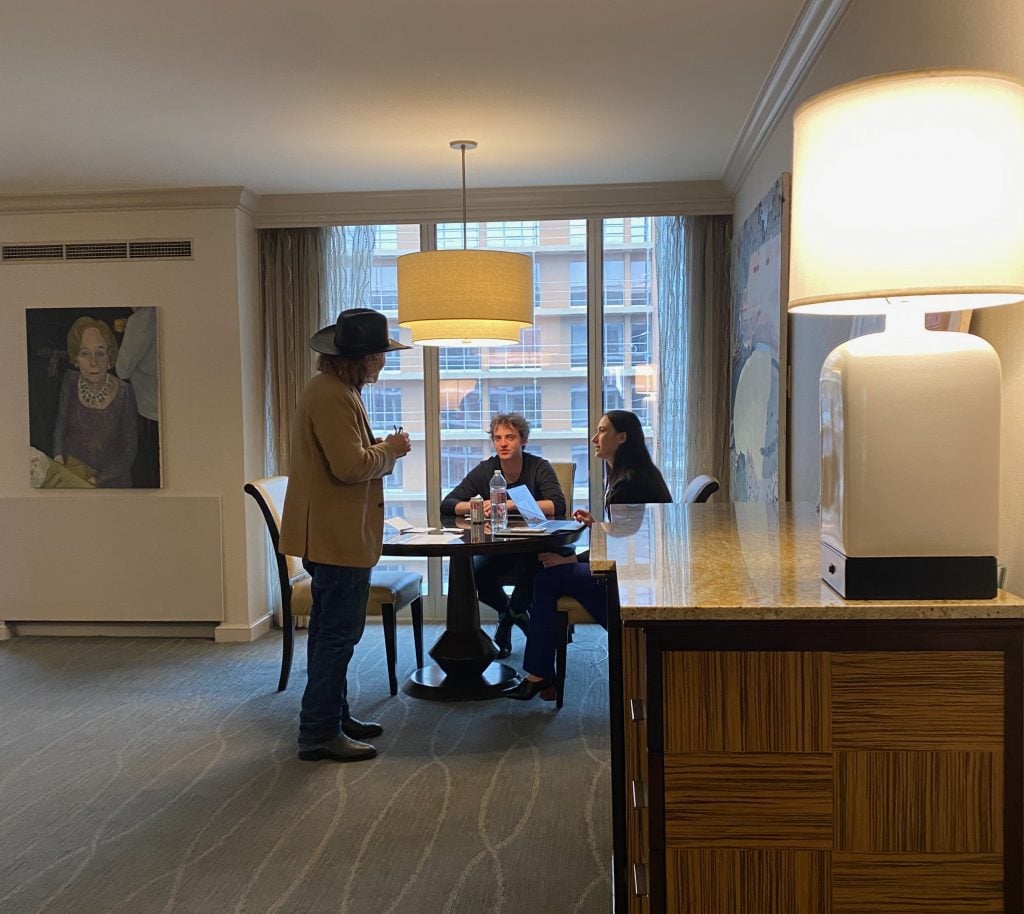
Lomex’s booth at the Dallas Invitational. Photo courtesy Janelle Zara
IN DEALERS WE TRUST
In Goss’s penthouse apartment (which features Rachel Whiteread, Robert Mapplethorpe, various emerging painters, and unbelievable views), I got the sense of an acute sensitivity for beauty (thus the affinity for female strip clubs) as well as trustworthiness and loyalty. “You have to surround yourself with people that actually are going to be honest with you,” he said, citing artist Tracey Emin, a longtime friend, for her brutal candor and guidance through the art world.
Goss insists on buying from longtime acquaintances who’ve proven a certain quality of character. As he pointed out two large Joshua Hagler paintings that he recently hung, he praised their seller, veteran Dallas dealer Cris Worley, for the care she shows her artists. “She works her ass off,” he said. “And her husband’s very good-looking, too.”
In Dallas, trust is an invaluable currency, and it’s earned over the long haul. “People here care—they want to get to know you and take you out to dinner,” said dealer Anna Meliksetian. “They don’t want to give their money to a stranger.” One collector she had been courting for several years without success surprised her on the VIP day of the fair, she added. “He came in with his wife, as though they had already discussed it, and made a big purchase.”
When time is short, word of mouth also counts for a lot in this town, where “I told my friends all about you” might be the highest compliment. “People who’ve been collecting for a while point their friends in the direction of galleries that they really like,” said Hathaway, the Night Gallery dealer, and this imprimatur is certainly coveted by out-of-towners. We were chatting on Saturday afternoon at the Dallas Invitational, a satellite fair at the Fairmont Hotel, where visitors and sales were still trickling in during its final hours.
Now in its second year, the Dallas Invitational was launched by James Cope, the founder of the local gallery And Now, who previously worked at the Goss-Michael Foundation in Dallas. In contrast to DAF, the Invitational had a decidedly tighter focus, with 14 invited galleries from New York, L.A., and London that Cope considers his peers: Jenny’s, Lomex, Hannah Hoffman, Francois Ghebaly, Bel-Ami among them.
At this fair, prices and dimensions went unlabeled, and most works were small-scale, my favorite being Alexandra Noel’s tiny paintings at Bel-Ami. The Invitational’s draws included the low cost of participation—simply the price of the hotel room—and entry into the local community’s good graces. “It helps to pay one’s respects, and lay as much groundwork as possible in advance,” said Clearing director John Utterson, who sold (and presold) a number of landscapes by Robert Zehnder. “This was the third time in six months or so that we had been to the city. I am certain it won’t be the last.”
Hathaway reported sales of a few paintings by Keita Morimoto, as well as visits from the trustees of local museums and a few out-of-town consultants. When a man with children in tow bashfully described his collection as just “a few pieces under $5,000,” Hathaway replied, “That’s great, this one’s only $4,000,” pointing to a kinetic sculpture of bucking orchids by Rachel Youn. We all shared a little chuckle.
